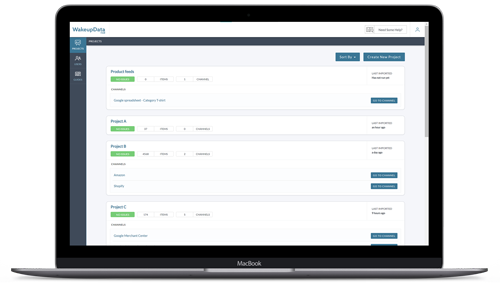How to optimise Google Shopping descriptions | WakeupData
Posted on April 2, 2018 (Last Updated: May 29, 2024)
When it comes to creating a successful product listing, many sellers believe that high-quality images and optimized titles are the most crucial elements. While these factors are indeed important, product descriptions also play a vital role in optimizing your product feeds. In fact, Google has recently emphasized the significance of product descriptions in contributing to the success of effective product listings.
While products without data in the description field can still be displayed, their reach and ability to compete with similar products will be greatly diminished. What a user reads (or doesn't read) about the product greatly influences their decision to make a purchase. Therefore, it is essential to focus on creating detailed and engaging descriptions that can convert your browsing audience into buyers.
Optimizing your descriptions is crucial for your product's ranking on Google Shopping. Despite the saying "a picture speaks a thousand words," search engines like Google cannot see images. These search engines crawl your feed to determine if your listing is relevant for different search queries. The keywords you use in both your title and description field play a vital role in Google determining that relevancy. Therefore, it is important to add accurate keywords not only to your title but also to your description.
Writing compelling product descriptions is essential for converting visitors into paying customers, especially when you have numerous products that share similar designs or functions. It can be challenging to create unique and engaging descriptions, but it is crucial to capture the attention of your audience and convince them to make a purchase.
To achieve this, it is important to keep your descriptions concise, high-quality, and devoid of unnecessary information. While brevity is key, you still need to effectively convey what the product is and how it works. By focusing on the key features and benefits of the product, you can provide potential customers with the information they need to make an informed decision.
A well-crafted product description can make a significant impact on your conversion rates. When writing descriptions, make sure to highlight the unique aspects of your product, address any pain points it solves, and emphasize the value it brings to the customer's life. By understanding your target audience and their needs, you can tailor your descriptions to speak directly to them, increasing the likelihood of conversion.
In summary, optimizing your product descriptions is crucial for driving conversions. By keeping them concise, high-quality, and tailored to your target audience, you can grab their attention, highlight the unique features of your product, and convince them to make a purchase. A well-crafted description can make all the difference in turning visitors into paying customers.
Now that we understand the importance of product descriptions, let's delve into the steps you can take to optimize your Google Shopping descriptions.
These are certainly important but the descriptions you give your products also play a vital role when you optimise your product feeds. In fact, Google announced in Q3 2020 that Product Descriptions would be playing an even more vital role in contributing to the success of effective product listings.
What a user reads (or doesn't read!) about the product hugely influences whether or not they will make that crucial purchase decision. Products submitted without data in the Description field will still be displayed, but their reach and ability to compete with similar products will be greatly diminished.
In this article we're taking a look at the importance of Product Descriptions to Google Shopping, and the steps you can take to create detailed descriptions that engage and convert your browsing audience into buyers.
Why should you optimize your Descriptions?
First and foremost, it contributes hugely towards your product's ranking on Google Shopping. Of course, a picture speaks a thousand words, but sadly search engines like Google cannot see images.
Search engines will crawl your feed to determine if your listing is relevant for different search queries. The keywords you use in both your title and description field play a vital role in Google determining that relevancy. That’s why it’s important to add accurate keywords to not only your title, but your description as well.
This process works like Search Engine Optimization (SEO), so the description structure has to make sense too. Finding effective and relevant long-tail keywords can dramatically increase your chances of ranking highly on search engines.

Writing compelling product descriptions is essential for converting visitors into paying customers, especially when you have numerous products that share similar designs or functions. It can be challenging to create unique and engaging descriptions, but it is crucial to capture the attention of your audience and convince them to make a purchase.
To achieve this, it is important to keep your descriptions concise, high-quality, and devoid of fluff. While brevity is key, you still need to effectively convey what the product is and how it works. By focusing on the key features and benefits of the product, you can provide potential customers with the information they need to make an informed decision.
A well-crafted product description can make a significant impact on your conversion rates. When writing descriptions, make sure to highlight the unique aspects of your product, address any pain points it solves, and emphasize the value it brings to the customer's life. By understanding your target audience and their needs, you can tailor your descriptions to speak directly to them, increasing the likelihood of conversion.
Avoid using generic and copied descriptions from manufacturers' websites, as this can harm your SEO rankings and discourage potential customers. Instead, take the time to craft original, engaging descriptions that showcase your brand's personality and differentiate you from your competitors.
In summary, optimizing your product descriptions is crucial for driving conversions. By keeping them concise, high-quality, and tailored to your target audience, you can grab their attention, highlight the unique features of your product, and convince them to make a purchase. A well-crafted description can make all the difference in turning visitors into paying customers.
How to optimize your Google Shopping Descriptions
You might have already read that Google lets you use 5,000 characters for your product descriptions. But I think it's fair to assume that no customer is likely to read an essay like that about your product!
So let's forget about that 5000 limit for a moment. Maybe that is fine for your own online store, where shoppers are only browsing your items.
When it comes to competitive markets like Google Shopping, you ideally want to keep your descriptions between around 500 to 1000 characters.
Even then, Search Engine Results Pages (SERPs), will shorten to descriptions down to a shortened view of between 150- 180 characters - which means including your most important info at the start - just as we saw with product titles.

Sort out keyword hierarchy first
As I mentioned above, the SERPs will severely limit the number of characters displayed for your product descriptions.
In order for your beautifully written and keyword-rich product descriptions to rank highly in search engine results, it is crucial to establish a hierarchy that prioritizes the most important factors at the beginning of the description. While it may be tempting to include all the relevant information throughout the description, search engine algorithms prioritize the initial characters, so it is essential to capture the attention of both search engines and potential customers right from the start.
By sorting out a hierarchy for your product descriptions, you can ensure that the most critical information, such as the product brand, type, and intended audience, is prominently featured in the first 180 characters. This way, even if the description is shortened by search engine results pages, the crucial details will still be visible to potential customers.
By prioritizing factors such as size, color, brand, material, texture, technical specifications, and special features in the first 180 characters, you can effectively convey the unique aspects of your product and address the needs and preferences of your target audience. This hierarchy not only improves the visibility of your product descriptions but also increases their effectiveness in driving conversions.
On the other hand, there are certain elements that you should avoid including in your product descriptions. Promotional text like "Free shipping" or "Sale," block capitals and spam punctuation, details about your company, descriptions of other products or accessories, payment or sales information, and Google categorization for the item should be omitted. These factors not only distract potential customers but also violate Google's rules and regulations for product listings.
To optimize your Google Shopping descriptions, it is also crucial to find the right keywords that will make your product relevant and easily discoverable by your target audience. Put yourself in the shoes of your customers and consider what keywords they might be searching for to find your product. Factors like product type, size, material, brand, texture, technical specifications, and special features should be incorporated into your description to enhance its relevance and appeal to potential customers.
In addition to keyword optimization, it is essential to consider your buyer persona when writing product descriptions. By understanding their interests, preferences, and decision-making processes, you can tailor your descriptions to include language that is unique, engaging, and persuasive. Highlight the benefits and solutions your product offers, and make it clear how it can improve the lives of your customers.
Furthermore, defining your tone of voice can differentiate your brand from competitors and give readers a strong impression of your organization's culture and personality. Whether you choose to sound like a big corporation or engage readers with personality and humor, your tone of voice should align with your brand identity and resonate with your target audience.
In summary, by establishing a hierarchy for your product descriptions, incorporating relevant keywords, and tailoring your language to your buyer persona, you can optimize your Google Shopping descriptions for maximum visibility and conversion. Remember to captivate potential customers from the start, prioritize key information, and avoid unnecessary elements that may distract or violate guidelines. With these strategies in place, your product descriptions will have a greater chance of ranking highly and driving conversions.
Similar to the factors in title construction, think about:
- Your product brand
- The type of product (e.g. laptop, jacket, rucksack)
- The intended audience
Now, work your way through the following list. These are factors that pretty much should ALWAYS be included in the first 180 characters of those descriptions:
- Size
- Color
- Brand
- Material
- Texture
- Technical specifications
- Special features
And while we're on this subject, I guess it makes sense to include some factors you should avoid as well!
As an existing or prospective Google Shopping merchant, you've probably already realized that Google has a lot of rules and regulations when it comes to your product listings and Merchant Center account.
Here are some factors to avoid in your descriptions:
- Promotional text, e.g: “Free shipping” or “Sale”
- BLOCK CAPITALS and spam punctuation (e.g: S*A*L*E or D.i.s.c.o.u.n.t)
- Describing your company (This is just about the product, not the business!)
- Details or descriptions of other products or accessories
- Information about payment or sales
- Including the Google categorization for that item (e.g., Clothing & Accessories > Clothing > Jackets)
Now find the right keywords for your Google Descriptions
You obviously want to be looking for keywords which are going to give you the most relevance and be found by the right shoppers. Here you have to put yourself in the perspective of your customer: what keywords might they be searching for to find your product, which attributes, factors and considerations are going to be important?
Yeah - it can definitely be a lot for first-time sellers to think about. We've outlined a few factors to think about below (with examples!)
Product Type

Make this as clear as possible. Okay, maybe the example above might overdo it slightly, but getting that produce type (and its varients, e.g: rucksack, backpack) is vital.
Size
No matter what you are selling, the size of the product is always going to be pretty crucial. Almost any shopper, whether looking for new sneakers, a bike or a laptop, will want to know what size the product is - so get that in the description asap.
Material
This also rings true for the product material. It doesn't matter if it's a baseball shirt or a handbag, your customer is going to want to know what material the product is made from.
Brand
Did you know that 65% of a company’s business comes from existing customers?For shoppers who are loyal to certain brands which you stock, the brand of a product could be the deciding factor in whether or not they click through to your ad.
For that reason, make sure you are always including the brand in those first few characters somewhere.

Texture
The issue with ecommerce shopping? You can't (well, not at the time of writing in 2019!) let you shoppers handle your product.
Therefore, your description needs to paint that picture for them. Is your product coarse, smooth, silky soft? If it's relevant, get that message across.
Technical Specifications
This is particularly true for electronics sellers. Add all the specifications so the shopper knows exactly what they are getting their hands on. This might include the processor, RAM, hard disk space, etc.
Special features
When it comes to standing out from the competition, having special features that set your product apart is crucial. These unique aspects not only catch the attention of potential customers but also contribute to greater conversions and return on investment (ROI). Whether it's an innovative technology, a customizable option, or an exclusive design, highlighting these special features can make your product irresistible to buyers. By showcasing what your product has that others don't, you create a compelling reason for customers to choose you over your competitors. So, make sure to emphasize these small yet impactful factors in your product descriptions to maximize conversions and achieve a higher ROI.

- Define Your Buyer Persona
Before writing your product descriptions try to have your buyer persona in mind. What websites do they visit, what are their interests and what kind of language will draw them in? Consider what they want to do to improve their business, what they want to achieve, and how they make decisions – all of this will help you target your descriptions to include more vivid, personal and persuasive language which speaks to your buyer persona.
Check out this Moosend blogpost on how to go about creating buyer personas for your products.
- Use language which is unique and engaging
Implementing this into your product descriptions will ensure that users can convert into paying customers. They want to know what’s in it for them. How does it make their lives better? Which problems does it take away?
- Define Your Tone of Voice
- Do NOT copy product descriptions
What benefits can improved product descriptions give?
This is a good question, luckily you’ve come to the right place! Legeakademiet approached WakeupData to hear about the possibility of improving the conversions via their Google Shopping feed.
They compared a 15-month period without using WakeupData with a 15-month period using our feed management tool to optimize their Google shopping feed. The results of improved product descriptions, as well as titles and images are shown below:
Read the full success story of Legeakademiet here.
Related: What is the Google Manufacturer Center and how does it differ from the Merchant Center?
Conclusion
Well planned, well written, and optimized product descriptions in Google Shopping can have a significant impact on your online business. Not only do they improve the visibility of your products, but they also play a crucial role in boosting click-through rates and ultimately preparing shoppers to make a purchase once they land on your product page.
When your product descriptions are carefully crafted, they act as a powerful tool to capture the attention of potential customers. By providing accurate and detailed information about your products, you instill confidence in shoppers and help them make informed buying decisions. A well-written description highlights the key features and benefits of your product, addressing the needs and desires of your target audience.
Optimizing your product descriptions for Google Shopping is especially important because it allows your products to be easily discovered by potential customers. By incorporating relevant keywords and phrases, you increase the chances of your products appearing in search results when shoppers are actively looking for what you offer. This visibility not only drives traffic to your product listings but also increases the likelihood of conversions.
Furthermore, when your product descriptions are optimized, they align with Google's guidelines and best practices, ensuring that your listings remain compliant and avoid any penalties or restrictions. By providing accurate and relevant information, you create a positive user experience and build trust with your audience.
In summary, well-planned, well-written, and optimized product descriptions are a crucial component of your Google Shopping strategy. They not only improve the visibility of your products but also increase click-through rates and drive conversions. By investing time and effort into crafting compelling and informative descriptions, you can effectively engage your target audience, boost your online presence, and ultimately achieve success in the competitive world of e-commerce.
Using this advice as a basis, you can then optimize your product images and add relevant keywords to your product descriptions (and titles) that you know customers are using to find your products.
By choosing WakeupData as your product feed management solution, you gain a professional and experienced service with results that speak for themselves.
Find out more about Selling on Google Shopping and get a free product-by-product analysis of your Google Shopping feed below:




